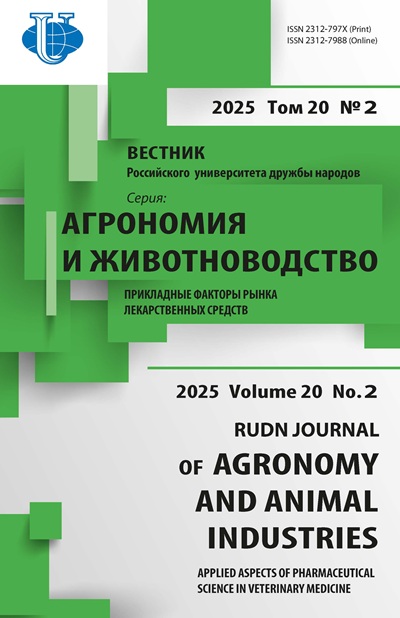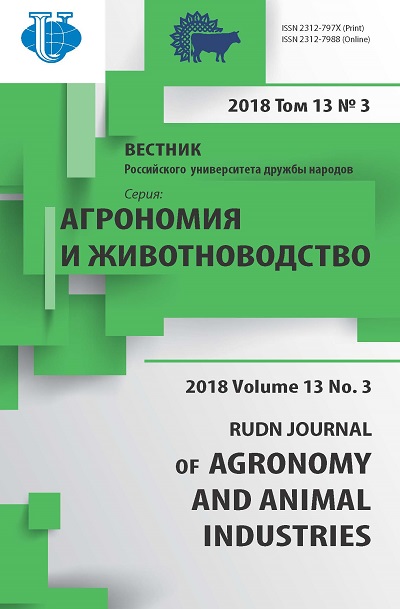Vol 13, No 3 (2018)
- Year: 2018
- Articles: 8
- URL: https://agrojournal.rudn.ru/agronomy/issue/view/1101
- DOI: https://doi.org/10.22363/2312-797X-2018-13-3
Full Issue
Agricultural technologies and land reclamation
INTERCROPPING MAIZE - COMMON BEAN ENHANCES MICROBIAL CARBON AND NITROGEN IN LOW-PHOSPHORUS SOIL UNDER MEDITERRANEAN CONDITIONS
Abstract
 177-184
177-184


WATER-SAVING IRRIGATION REGIMES FOR VEGETABLE CROP PRODUCTION UNDER CONDITIONS OF VOLGA-DON INTERFLUVE
Abstract
Irrigation regimes and rates of mineral fertilizers for obtaining the expected yields of vegetable crops under conditions of light chestnut soils of the Volga-Don interfluve are considered in the study. We established that irrigation regimes and norms of mineral fertilizers proposed in our field study for table beet (Beta vulgaris) and carrot ( Daucus carota) cultivation allow yielding in the range of 60...80 t/ha. Thus, for example, the maximum yield of table beet 84.1 t/ha was obtained in the variant with 80% pre-irrigation soil moisture and N230P180K100 fertilizer at a variable depth of soil moistening (0.3...0.5 m). Changes in fertilizer dose from N130P80K20 to N230P180K100 contributed to 63.7...84.1 t/ha yield increase, which is 10-20% higher compared to other variants. Change in soil moisture from 70-80-70 to 80-80-80% of FMC in combination with fertilizer dose from N150P70K180 to N210P100K260 increased carrot yields from an average of 57.9 to 81.6 t/ha. The highest yields (81.6 t/ha) were obtained when maintaining pre-irrigation soil moisture of 80-80-80% of FMC and applying N210P100K260 fertilizer rate. In general, beet and carrot cultivation on light chestnut soils using drip irrigation is the most efficient. To maintain water regimes of the soil adopted by the experiment, a different irrigation frequency was required. When increasing humidity level from 70 to 90% FMC frequency of irrigation increases, and irrigation rate decreases. The total consumption of moisture in the experiments increased with an increase in moisture content - from 4,417 m3/ha in the variant with 70% of FMC to 5105 m3/ha in the variant with 90% of FMC. The largest total water consumption of table beet was noted in the variant with a differentiated depth of soil wetting and averaged 4,530-5,105 m3/ha. The share of irrigation water in the total water consumption of plants increased from 73.3 to 75.7%. Application of mineral fertilizers reduces water consumption of table beet. The smallest coefficient was obtained in the second irrigation regime variant, when humidity was maintained at 80% of FMC with different wetting depth. This situation was observed in all variants of irrigation regimes and fertilizer applications. This confirms that differentiating wetting depth according to table beet growth stage makes it possible to use irrigation water more economically at all rates mineral fertilizer application.
 185-193
185-193


EFFICIENCY ESTIMATION OF STRIPTILL SOIL PROCESSING TECNOLOGY
Abstract
 194-206
194-206


RICE CULTIVATION IN AMUR REGION
Abstract
 207-215
207-215


CROP ROTATIONS ENSURING THE GREATEST YIELDS UNDER DRY CONDITIONS OF THE LOWER VOLGA REGION WATER-SAVING IRRIGATION REGIMES FOR VEGETABLE CROP PRODUCTION UNDER CONDITIONS OF VOLGA-DON INTERFLUVE
Abstract
 216-223
216-223


OPTIMIZATION OF INNOVATIVE STRIP-TILL TECHNOLOGY OF MAIZE CULTIVATION FOR GRAIN ON BLACK SOILS IN STEPPE ZONE OF VOLGOGRAD REGION
Abstract
 224-231
224-231


LOCAL IRRIGATION METHODS FOR VEGETABLE PRODUCTION IN SOUTH OF RUSSIA
Abstract
 232-240
232-240


WATER-SAVING IRRIGATION REGIMES FOR VEGETABLE CROP PRODUCTION UNDER CONDITIONS OF VOLGA-DON INTERFLUVE
Abstract
 241-249
241-249
















